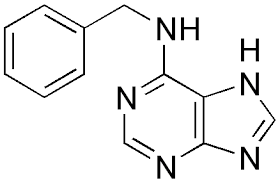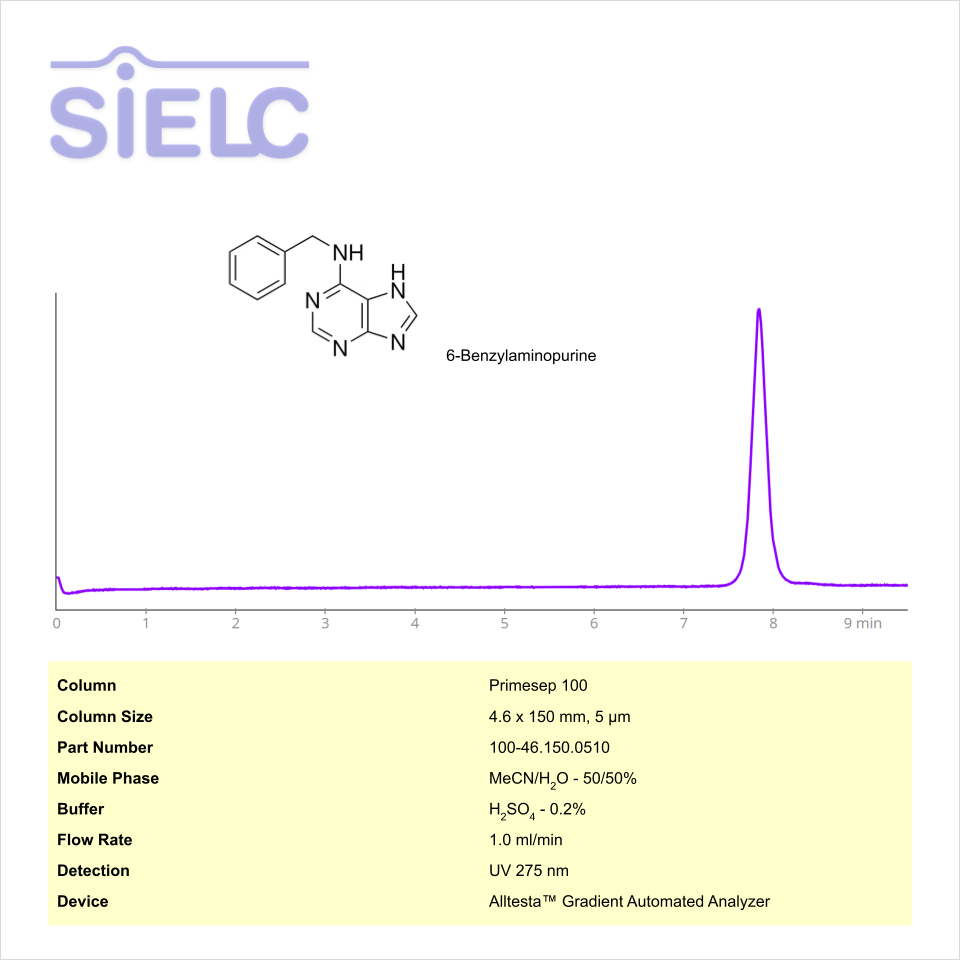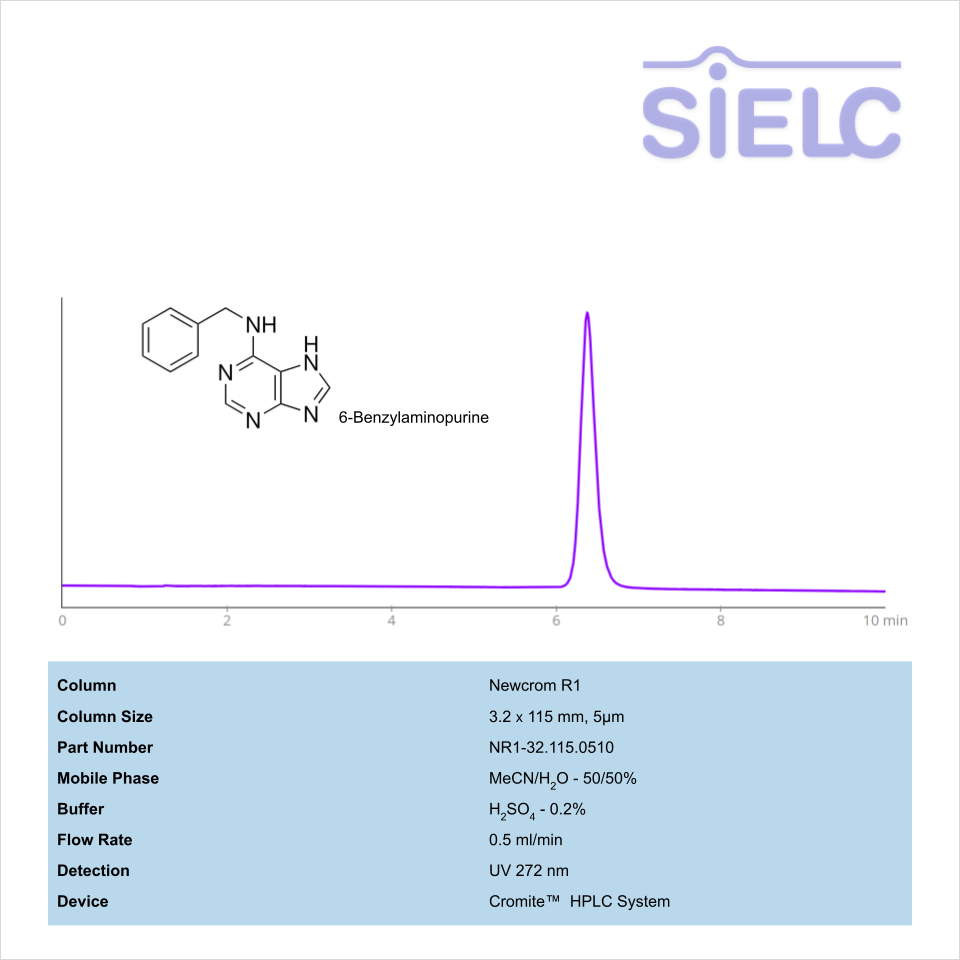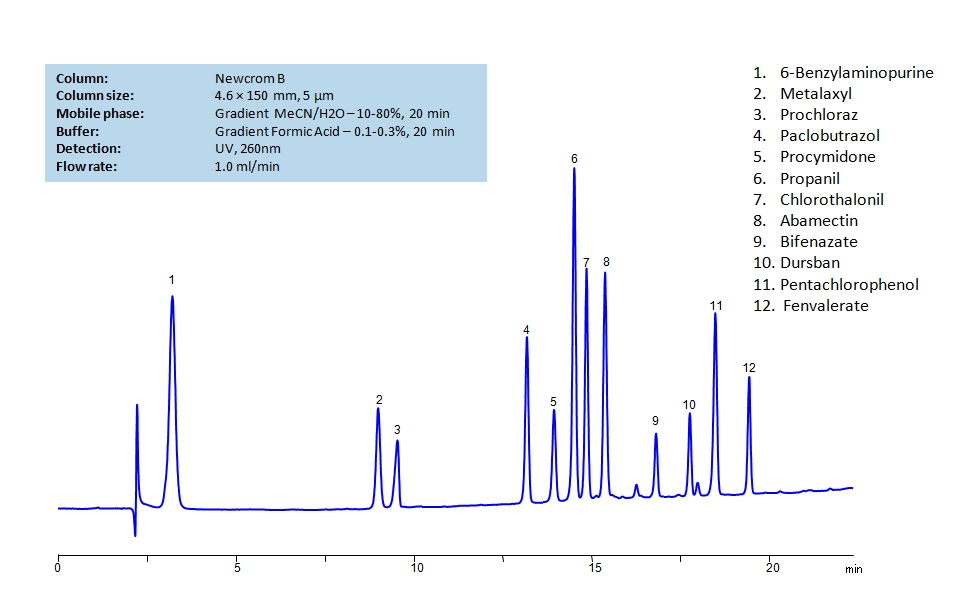| CAS Number | 1214-39-7 |
|---|---|
| Molecular Formula | C12H11N5 |
| Molecular Weight | 225.25 |
| InChI Key | NWBJYWHLCVSVIJ-UHFFFAOYSA-N |
| LogP | 2.1 |
| Synonyms |
|
Applications:
HPLC Method for Analysis of 6-Benzylaminopurin on Primesep 100 Column on Alltesta™
September 29, 2025
HPLC Method for 6-Benzylaminopurine on Primesep 100 by SIELC Technologies
High Performance Liquid Chromatography (HPLC) Method for Analysis of 6-Benzylaminopurine
6-Benzylaminopurine is a plant growth regulation compound with the molecular formula C12H11N5. It’s presence in asparagus, for example, leads to deeper color, increased firmness, and a decrease in fibrous hardness. In general, it stimulates cell division and differentiation.
6-Benzylaminopurine can be retained and analyzed using the Primesep 100 stationary phase column. The analysis utilizes an isocratic method with a simple mobile phase consisting of water and acetonitrile (MeCN) with a sulfuric acid buffer. Detection is performed using UV.
| Column | Primesep 100, 4.6 x 150 mm, 5 µm, 100 A, dual ended |
| Mobile Phase | MeCN – 50% |
| Buffer | H2SO4 – 0.2% |
| Flow Rate | 1.0 ml/min |
| Detection | UV 275 nm |
| Class of Compounds | Natural Compound |
| Analyzing Compounds | 6-Benzylaminopurine |
Application Column
Primesep 100
Column Diameter: 4.6 mm
Column Length: 150 mm
Particle Size: 5 µm
Pore Size: 100 A
Column options: dual ended

HPLC Method for Analysis of 6-Benzylaminopurine on Newcrom R1 Column
September 18, 2025
HPLC Method for 6-Benzylaminopurine on Newcrom R1 by SIELC Technologies
High Performance Liquid Chromatography (HPLC) Method for Analysis of 6-Benzylaminopurine
6-Benzylaminopurine is a plant growth regulation compound with the molecular formula C12H11N5. It’s presence in asparagus, for example, leads to deeper color, increased firmness, and a decrease in fibrous hardness. In general, it stimulates cell division and differentiation.
6-Benzylaminopurine can be retained and analyzed using the Newcrom R1 stationary phase column. The analysis utilizes an isocratic method with a simple mobile phase consisting of water and acetonitrile (MeCN) with a ammonium formate buffer. Detection is performed using UV.
| Column | Newcrom R1, 3.2 x 100 mm, 5 µm, 100 A, dual ended |
| Mobile Phase | MeCN – 50% |
| Buffer | H2SO4-0.2% |
| Flow Rate | 0.5 ml/min |
| Detection | UV 272 nm |
| Class of Compounds | Synthetic Cytokinin |
| Analyzing Compounds | 6-Benzylaminopurine |
Application Column
Newcrom R1
Column Diameter: 3.2 mm
Column Length: 100 mm
Particle Size: 5 µm
Pore Size: 100 A
Column options: dual ended

UV-Vis Spectrum of N6-Benzyladinine
July 11, 2025
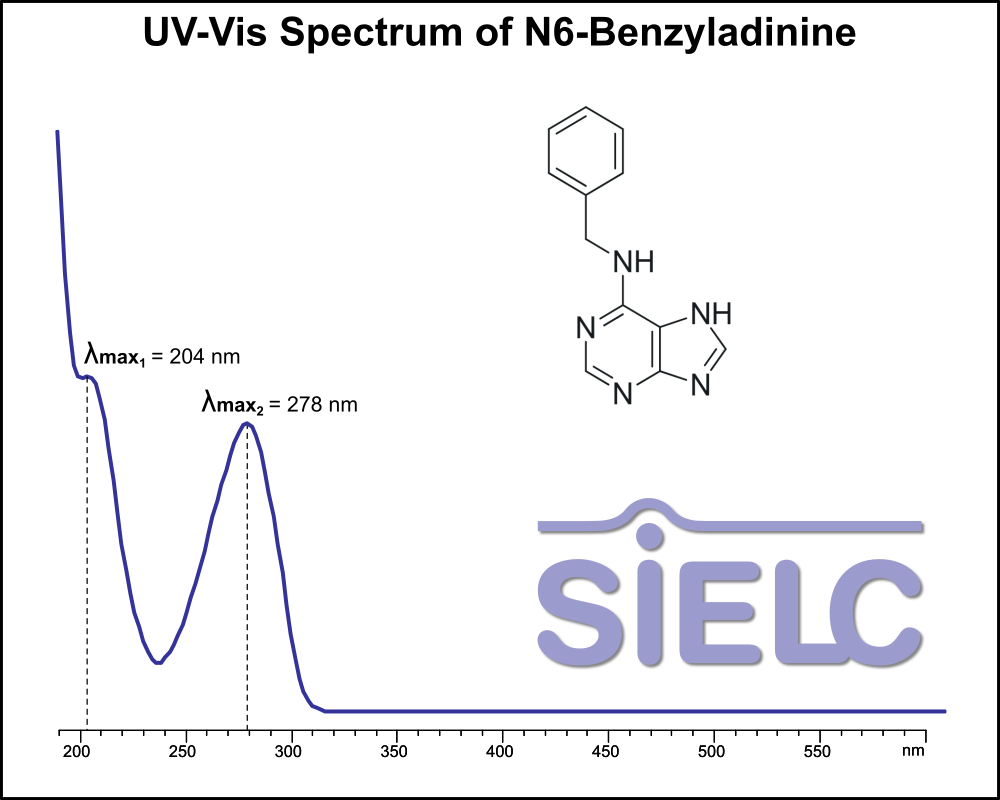
For optimal results in HPLC analysis, it is recommended to measure absorbance at a wavelength that matches the absorption maximum of the compound(s) being analyzed. The UV spectrum shown can assist in selecting an appropriate wavelength for your analysis. Please note that certain mobile phases and buffers may block wavelengths below 230 nm, rendering absorbance measurement at these wavelengths ineffective. If detection below 230 nm is required, it is recommended to use acetonitrile and water as low UV-transparent mobile phases, with phosphoric acid and its salts, sulfuric acid, and TFA as buffers.
For some compounds, the UV-Vis Spectrum is affected by the pH of the mobile phase. The spectra presented here are measured with an acidic mobile phase that has a pH of 3 or lower.

HPLC MS Method for the Analysis of Cytokinins: A Phytohormone Class and Brassinazole on Primesep 200 Column
September 11, 2024
High Performance Liquid Chromatography (HPLC) MS Method for Analysis of trans-Zeatin, Kinetin, N6-(Δ2-Isopentenyl)adenine, Thidiazuron, 6-Benzylaminopurine, Brassinazole on Primesep 200 by SIELC Technologies
Separation type: Liquid Chromatography Mixed-mode SIELC Technologies
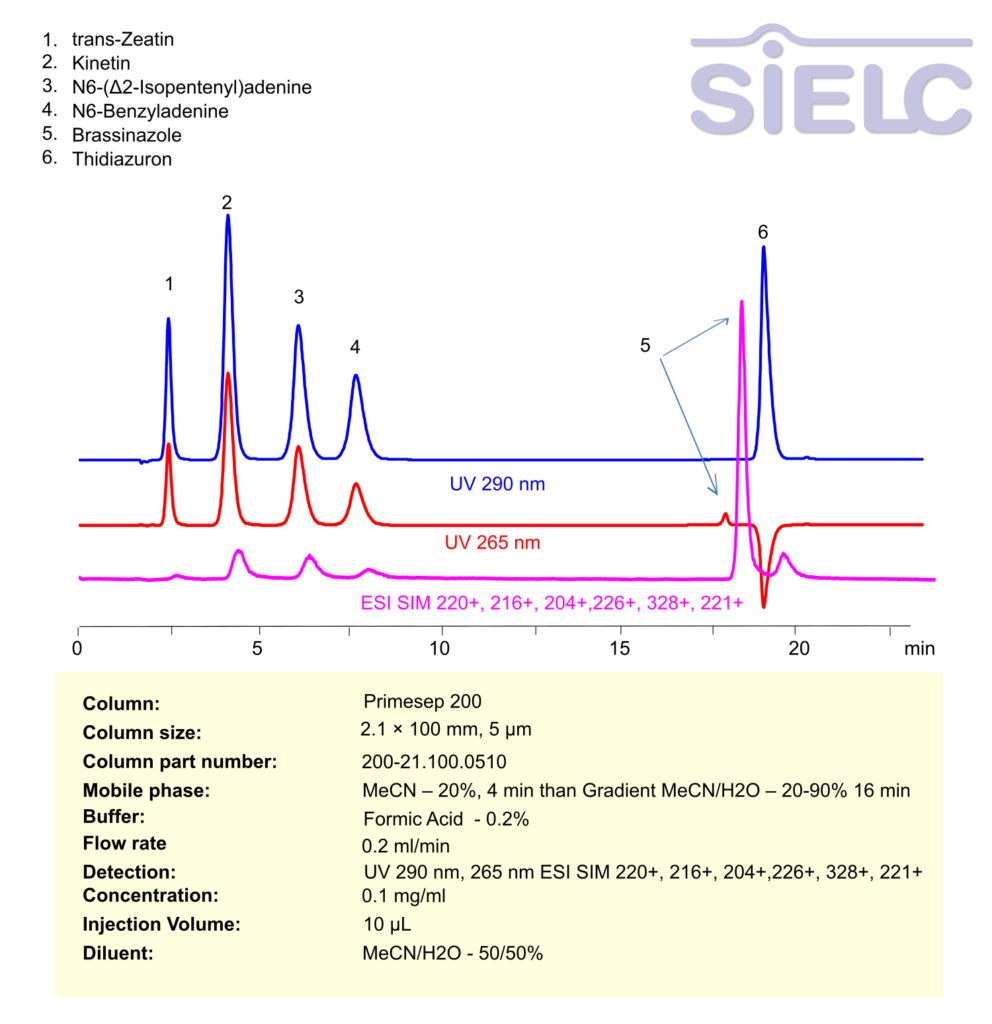
High Performance Liquid Chromatography (HPLC) Method for Analysis of trans-Zeatin, Kinetin, N6-(Δ2-Isopentenyl)adenine, Thidiazuron, 6-Benzylaminopurine, Brassinazole
It looks like you’re listing a series of compounds, most of which are cytokinins or related plant hormones. Here’s a brief overview and classification for the compounds you mentioned:
trans-Zeatin:
- A type of cytokinin.
- Naturally occurring in plants and plays a key role in promoting cell division and growth.
Kinetin:
- A synthetic cytokinin.
- Used in plant tissue culture to stimulate cell division.
N6-(Δ2-Isopentenyl)adenine (iP):
- Another cytokinin.
- Found in plants and is involved in regulating growth, development, and differentiation.
N6-Benzyladenine (BA):
- A synthetic cytokinin.
- Commonly used in agricultural practices to enhance plant growth and delay senescence.
Brassinazole:
- Not a cytokinin, but a brassinosteroid biosynthesis inhibitor.
- Used to study the role of brassinosteroids (another class of phytohormones) in plants.
Thidiazuron (TDZ):
- A phenylurea derivative that acts as a cytokinin-like compound.
- Widely used in plant tissue culture to promote shoot regeneration and induce cytokinin-like effects.
trans-Zeatin, Kinetin, N6-(Δ2-Isopentenyl)adenine, Thidiazuron, 6-Benzylaminopurine, Brassinazole can be retained, separated and analyzed using a Primesep 200 mixed-mode stationary phase column. The analysis employs an isocratic method with a simple mobile phase comprising water, acetonitrile (MeCN), and formic acid as a buffer. This method allows for detection using UV 290, 265 nm.
You can find detailed UV spectra of trans-Zeatin, Kinetin, N6-(Δ2-Isopentenyl)adenine, Thidiazuron, 6-Benzylaminopurine, Brassinazole and information about its various lambda maxima by visiting the following link.
| Column | Primesep 200, 2.1 x 100 mm, 5 µm, 100 A, dual ended |
| Mobile Phase | MeCN – 20%, 4 min than Gradient MeCN/H2O – 20-90% 16 min |
| Buffer | Formic Acid -0.2% |
| Flow Rate | 0.2 mg/ml |
| Detection | UV 290 nm, 265 nm ESI SIM 220+, 216+, 204+,226+, 328+, 221+ |
| Class of Compounds | Phytohormone |
| Analyzing Compounds | trans-Zeatin, Kinetin, N6-(Δ2-Isopentenyl)adenine, Thidiazuron, 6-Benzylaminopurine, Brassinazole |
Application Column
Primesep 200
Column Diameter: 2.1 mm
Column Length: 100 mm
Particle Size: 5 µm
Pore Size: 100 A
Column options: dual ended
Brassinazole
Kinetin
N6-(Δ2-Isopentenyl)adenine
Thidiazuron
trans-Zeatin
LC MS Detection

HPLC Method for Analysis of 6-Benzylaminopurine (N6-Benzyladenine) on Primesep 100 Column
September 11, 2024
High Performance Liquid Chromatography (HPLC) MS Method for Analysis of 6-Benzylaminopurine (N6-Benzyladenine) on Primesep 100 by SIELC Technologies
Separation type: Liquid Chromatography Mixed-mode SIELC Technologies
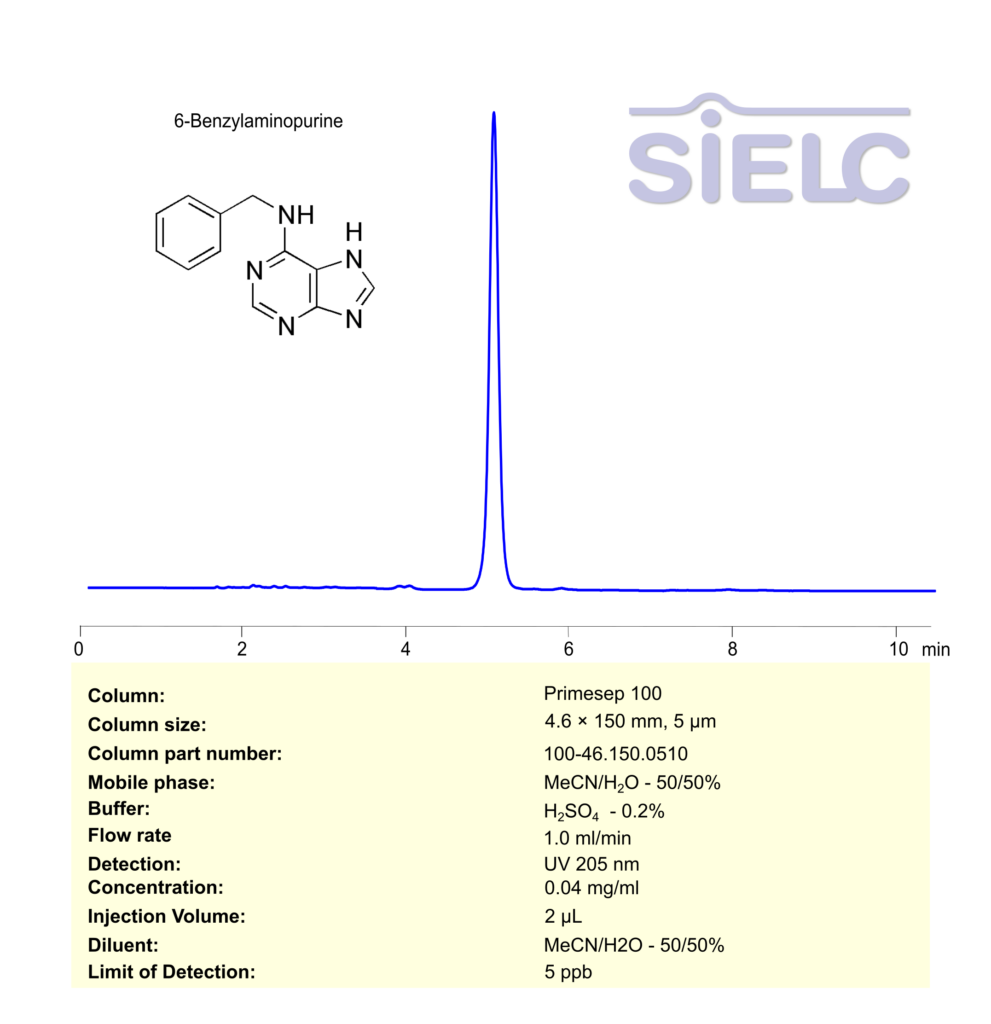
High Performance Liquid Chromatography (HPLC) Method for Analysis of 6-Benzylaminopurine
6-Benzylaminopurine (N6-Benzyladenine, 6-BAP or BAP) is a synthetic cytokinin commonly used in plant biology and tissue culture to stimulate cell division and growth. It is a potent growth regulator and is applied to enhance plant tissue differentiation, particularly for shoot induction.
Key properties:
- Function: Promotes cell division (cytokinesis), shoot formation, and delays senescence in plant tissues.
- Applications:
- Extensively used in plant tissue culture for micropropagation, promoting the growth of shoots in various plant species.
- Also used to improve fruit set and increase crop yields in agricultural practices.
6-Benzylaminopurine is one of the most commonly used cytokinins in horticulture and laboratory studies.
6-Benzylaminopurine can be retained, separated and analyzed using a Primesep 100 mixed-mode stationary phase column. The analysis employs an isocratic method with a simple mobile phase comprising water, acetonitrile (MeCN), and sulfuric acid as a buffer. This method allows for detection using UV 210 nm.
You can find detailed UV spectra of 6-Benzylaminopurine and information about its various lambda maxima by visiting the following link.
| Column | Primesep 100, 4.6 x 150 mm, 5 µm, 100 A, dual ended |
| Mobile Phase | MeCN – 50% |
| Buffer | H2SO4 -0.2% |
| Flow Rate | 1.0 ml/min |
| Detection | UV 205 nm |
| Sample | 0.1 mg/ml |
| Diluent | MeCN/H2O- 50/50% |
| LOD* | 5 ppb |
| Class of Compounds | Phytohormone |
| Analyzing Compounds | 6-Benzylaminopurine |
Application Column
Primesep 100
Column Diameter: 4.6 mm
Column Length: 150 mm
Particle Size: 5 µm
Pore Size: 100 A
Column options: dual ended

HPLC Determination of 6-Benzylaminopurine on Newcrom R1 Column
June 11, 2024
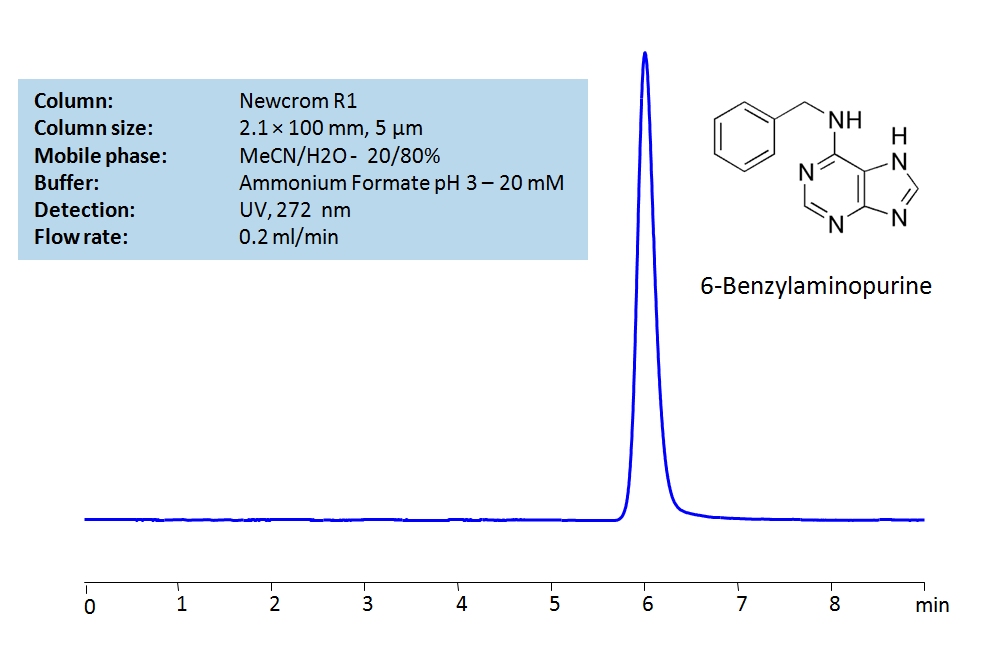
Condition
| Column | Newcrom R1, 2.1 x 100 mm, 5 µm, 100 A, dual ended |
| Mobile Phase | MeCN/H2O – 20/80% |
| Buffer | AmFm pH 3.0 – 20 mM |
| Flow Rate | 0.2 ml/min |
| Detection | UV, 272 nm |
Description
| Class of Compounds | Hydrophobic, Herbicide, Pesticide |
| Analyzing Compounds | 6-Benzylaminopurine |
Application Column
Newcrom R1
Column Diameter: 2.1 mm
Column Length: 100 mm
Particle Size: 5 µm
Pore Size: 100 A
Column options: dual ended

HPLC Separation of 12 Pesticides on Newcrom B Column
January 24, 2020
HPLC Method for 6-Benzylaminopurine, Metalaxyl (UV), Prochloraz, Paclobutrazol, Propanil, Chlorothalonil, Chlorpyrifos-methyl (Dursban), Pentachlorophenol, Fenvalerate, Abamectin, Procymidone, Bifenazate on Newcrom B by SIELC Technologies
High Performance Liquid Chromatography (HPLC) Method for Analysis of 6-Benzylaminopurine, Metalaxyl (UV), Prochloraz, Paclobutrazol, Propanil, Chlorothalonil, Chlorpyrifos-methyl (Dursban), Pentachlorophenol, Fenvalerate, Abamectin, Procymidone, Bifenazate.
6-Benzylaminopurine is a plant growth regulation compound with the molecular formula C12H11N5. It’s presence in asparagus, for example, leads to deeper color, increased firmness, and a decrease in fibrous hardness. In general, it stimulates cell division and differentiation.
Metalaxyl, also known as methyl N-(methoxyacetyl)-N-(2,6-xylyl)-DL-alaninate, is a systemic fungicide with the chemical formula C15H21NO4. It is used to control Pythium and Phytophthora in vegetables. It has suffered a resistance problem going back to the 1980s.
Prochloraz is an imidazole fungicide with the chemical formula C15H16Cl3N3O2. It is used widely across Europe, Asia, South America, and Australia, but is not registered for use in the United States. It works as an inhibitor of the enzyme lanosterol 14α-demethylase.
Paclobutrazol (PBZ) is a synthetic triazole compound with the chemical formula C15H20ClN3O. It is used to control plant growth as an antagonist of the plant hormone gibberellin. Through reducing reducing internodal growth, it causes stronger stems, greater root growth, and earlier fruitset. It can also reduce frost sensitivity in plants.
Procymidone is a pesticide and fungicide with the chemical formula C13H11Cl2NO2. It is typically used to kill unwanted ferns, nettles, and fungi in lupins, grapes, stone fruit, and strawberries.
Propanil is a contact herbicide with the chemical formula C9H9Cl2NO. It is one of the most widely used herbicides in America. It works as an inhibitor of photosynthesis and CO2 fixation in weeds.
Chlorothalonil is a compound with a variety of uses as a fungicide, wood protectant, pesticide, and acaricide. It is used predominantly on peanuts, potatoes, and tomatoes. Outside of agriculture, it is also used in paints, resins, emulsions, and coatings. It’s chemical formula is C8Cl4N2.
Abamectin is a insecticide with the chemical formulas C48H72O14 and C47H70O14. It is also used to control fire ant populations. In veterinary cases, it is used to deworm horses as well as an antihelmintic.
Bifenazate is pesticide with the chemical formula C17H20N2O3. It is typically used to control a large variety of mite pests in plants in various settings. It works through modulating GABA receptors and inhibiting complex III of the mitochondrial electron transport chain.
Dursban is a highly toxic organophosphate with the chemical formula C9H11Cl3NO3PS. It works through interrupting the electrochemical processes in nerves. This leads to a build-up of acetylcholine, which leads to paralysis and eventual death.
Pentachlorophenol is a manufactured chemical with the chemical formula C6HCl5O. It is most often used as herbicide, insecticide, fungicide, algaecide, and disinfectant. Exposure to it can cause damage to liver, kidney, blood, lungs, eyes, skin, and mouth. It is classified as a probable human carcinogen.
Fenvalerate is synthetic pyrethroid insecticide with the chemical formula C25H22ClNO3. It is used against a wide range of pests, partially due to it’s moderate mammalian toxicity following short-term and acute exposure. It is the most toxic to bees and fish. Upon contact, it may irritate skin and eyes.
6-Benzylaminopurine, Metalaxyl (UV), Prochloraz, Paclobutrazol, Propanil, Chlorothalonil, Chlorpyrifos-methyl (Dursban), Pentachlorophenol, Fenvalerate, Abamectin, Procymidone, Bifenazate can be retained and analyzed using the Newcrom B stationary phase column. The analysis utilizes an isocratic method with a simple mobile phase consisting of water and acetonitrile (MeCN) with a formic acid buffer. Detection is performed using UV.
| Column | Newcrom B, 4.6 x 150 mm, 5 µm, 100 A, dual ended |
| Mobile Phase | MeCN/H2O |
| Buffer | Formic Acid |
| Flow Rate | 1.0 ml/min |
| Detection | UV, 260 nm |
| Class of Compounds | Hydrophobic, Herbicide, Pesticide |
| Analyzing Compounds | 6-Benzylaminopurine, Metalaxyl (UV), Prochloraz, Paclobutrazol, Propanil, Chlorothalonil, Chlorpyrifos-methyl (Dursban), Pentachlorophenol, Fenvalerate, Abamectin, Procymidone, Bifenazate |
Application Column
Newcrom B
Column Diameter: 4.6 mm
Column Length: 150 mm
Particle Size: 5 µm
Pore Size: 100 A
Column options: dual ended
Abamectin
Bifenazate
Chlorothalonil
Chlorpyrifos-methyl (Dursban)
Fenvalerate
Metalaxyl (UV)
Paclobutrazol
Pentachlorophenol
Prochloraz
Procymidone
Propanil

HPLC Determination of 6-Benzylaminopurine (N6-Benzyladenine) on Newcrom B Column
January 10, 2020
HPLC Method for 6-Benzylaminopurine on Newcrom B by SIELC Technologies
High Performance Liquid Chromatography (HPLC) Method for Analysis of 6-Benzylaminopurine.
6-Benzylaminopurine is a plant growth regulation compound with the molecular formula C12H11N5. It’s presence in asparagus, for example, leads to deeper color, increased firmness, and a decrease in fibrous hardness. In general, it stimulates cell division and differentiation.
6-Benzylaminopurine can be retained and analyzed using the Newcrom B stationary phase column. The analysis utilizes an isocratic method with a simple mobile phase consisting of water and acetonitrile (MeCN) with an ammonium formate[ buffer. Detection is performed using UV.
| Column | Newcrom B, 4.6 x 150 mm, 5 µm, 100 A, dual ended |
| Mobile Phase | MeCN/H2O – 20/80% |
| Buffer | AmFm pH 3.0 – 20 mM |
| Flow Rate | 1.0 ml/min |
| Detection | UV, 272 nm |
| Class of Compounds | Hydrophobic, Herbicide, Pesticide |
| Analyzing Compounds | 6-Benzylaminopurine |
Application Column
Newcrom B
Column Diameter: 4.6 mm
Column Length: 150 mm
Particle Size: 5 µm
Pore Size: 100 A
Column options: dual ended

